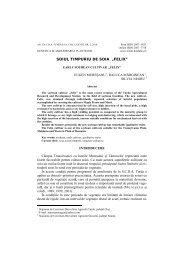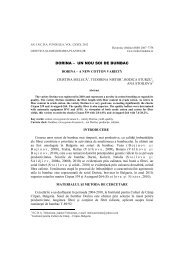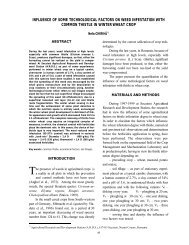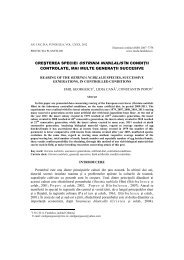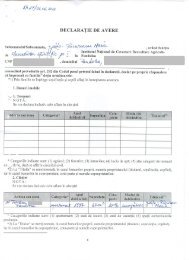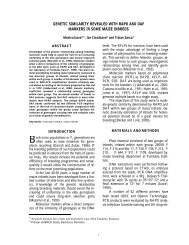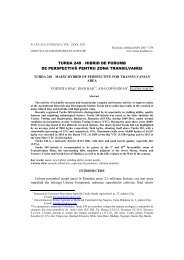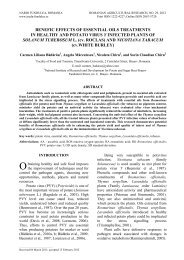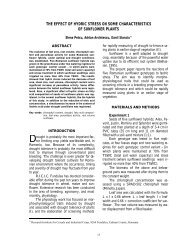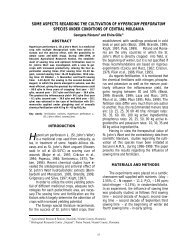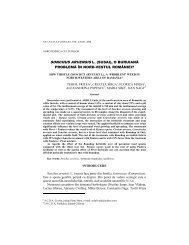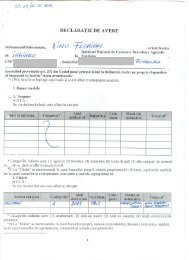pre-harvest amylase activity and sprouting in romanian wheat cultivars
pre-harvest amylase activity and sprouting in romanian wheat cultivars
pre-harvest amylase activity and sprouting in romanian wheat cultivars
You also want an ePaper? Increase the reach of your titles
YUMPU automatically turns print PDFs into web optimized ePapers that Google loves.
PRE-HARVEST AMYLASE ACTIVITY AND SPROUTING IN ROMANIAN WHEAT CULTIVARS<br />
Pompiliu Mustăţea 1 , Nicolae N. Săulescu 1 , Gheorghe Ittu 1 , Cornelia Tican 2 ,<br />
Iust<strong>in</strong>a Lobonţiu 3 , Gheorghe Bunta 4<br />
ABSTRACT<br />
High <strong>amylase</strong> <strong>activity</strong> <strong>and</strong> <strong>pre</strong>-<strong>harvest</strong> <strong>sprout<strong>in</strong>g</strong> have become major<br />
limit<strong>in</strong>g factors of <strong>wheat</strong> quality <strong>and</strong> yield <strong>in</strong> Romania. A study was<br />
conducted on 14 Romanian <strong>cultivars</strong> grown <strong>in</strong> yield trials <strong>in</strong> 10 environments<br />
which had favourable conditions for <strong>pre</strong>-<strong>harvest</strong> <strong>sprout<strong>in</strong>g</strong> <strong>in</strong><br />
2005. Variations caused by environments <strong>and</strong> genotypes were very<br />
significant <strong>and</strong> of similar magnitude. Fall<strong>in</strong>g number was correlated with<br />
total ra<strong>in</strong>fall from June 1 to <strong>harvest</strong> time. Scores from artificial test on<br />
spikes correlated well with percentage of sprouted gra<strong>in</strong>s <strong>in</strong> the field<br />
<strong>and</strong> with fall<strong>in</strong>g number. Many new Romanian w<strong>in</strong>ter <strong>wheat</strong> <strong>cultivars</strong>,<br />
obta<strong>in</strong>ed us<strong>in</strong>g selection based on artificial tests, had a good resistance<br />
to <strong>pre</strong>-<strong>harvest</strong> <strong>sprout<strong>in</strong>g</strong>, especially the new, recently registered <strong>wheat</strong><br />
<strong>cultivars</strong>, Glosa <strong>and</strong> Faur, <strong>and</strong> the perspective l<strong>in</strong>e Izvor.<br />
Key words: <strong>amylase</strong> <strong>activity</strong>, <strong>pre</strong>-<strong>harvest</strong> <strong>sprout<strong>in</strong>g</strong>, <strong>wheat</strong><br />
W<br />
INTRODUCTION<br />
heat production <strong>and</strong> quality <strong>in</strong> Romania<br />
is strongly <strong>in</strong>fluenced by climatic factors.<br />
Among them, ra<strong>in</strong>s dur<strong>in</strong>g maturity, before<br />
<strong>harvest</strong>, can cause an <strong>in</strong>crease of <strong>amylase</strong><br />
<strong>activity</strong> <strong>in</strong> the gra<strong>in</strong>s <strong>and</strong> <strong>pre</strong>-<strong>harvest</strong> <strong>sprout<strong>in</strong>g</strong>,<br />
with important negative <strong>in</strong>fluence on breadmak<strong>in</strong>g<br />
quality <strong>and</strong> even yield.<br />
The enzyme alpha-<strong>amylase</strong> is synthesized<br />
<strong>in</strong> the aleurone layer <strong>and</strong> scutellum <strong>and</strong> released<br />
<strong>in</strong> the endosperm to decompose the<br />
starch <strong>in</strong>to sugars available for germ<strong>in</strong>ation<br />
(Lunn et al., 2002). Pre-<strong>harvest</strong> <strong>in</strong>itiation of this<br />
process is harmful for quality by degrad<strong>in</strong>g the<br />
starch, reduc<strong>in</strong>g gra<strong>in</strong> test weight, decreas<strong>in</strong>g<br />
the absorption capacity of the flour, the<br />
strength of the dough <strong>and</strong> f<strong>in</strong>ally the loaf volume<br />
(Humphreys <strong>and</strong> Noll, 2002).<br />
Pre-<strong>harvest</strong> <strong>sprout<strong>in</strong>g</strong> (PHS), follow<strong>in</strong>g<br />
the <strong>in</strong>crease of <strong>amylase</strong> <strong>activity</strong>, besides the<br />
negative effects on quality, can also cause an<br />
yield reduction as a result of metaboliz<strong>in</strong>g part<br />
of the starch stored <strong>in</strong> the gra<strong>in</strong>s, a decrease of<br />
seed germ<strong>in</strong>ation energy <strong>and</strong> seedl<strong>in</strong>g vigour<br />
(Cseresnyes <strong>and</strong> Săulescu, 1989), <strong>and</strong> can also<br />
favour contam<strong>in</strong>ation of the gra<strong>in</strong>s with potentially<br />
tox<strong>in</strong> producer fungi <strong>and</strong> bacteria.<br />
Flour produced from sprouted gra<strong>in</strong>s or<br />
gra<strong>in</strong>s with high <strong>amylase</strong> <strong>activity</strong> is considered<br />
of low quality <strong>and</strong> gives bread with lower loaf<br />
volume <strong>and</strong> compact <strong>and</strong> sticky crumb<br />
(Ceapoiu et al., 1984).<br />
Despite the fact that <strong>in</strong> Romania <strong>wheat</strong><br />
maturation usually co<strong>in</strong>cides with a dry, less<br />
ra<strong>in</strong>y period, <strong>pre</strong>-<strong>harvest</strong> <strong>sprout<strong>in</strong>g</strong> can have<br />
important economic consequences. The year<br />
2005, with heavy ra<strong>in</strong>s <strong>pre</strong>ced<strong>in</strong>g <strong>and</strong> dur<strong>in</strong>g<br />
<strong>harvest</strong>, allowed a good characterisation <strong>sprout<strong>in</strong>g</strong><br />
resistance <strong>and</strong> <strong>amylase</strong> <strong>activity</strong> of Romanian<br />
<strong>wheat</strong> <strong>cultivars</strong>.<br />
MATERIAL AND METHODS<br />
Amylase <strong>activity</strong> was estimated by the<br />
Hagberg Fall<strong>in</strong>g Number (FN) <strong>in</strong> 25 w<strong>in</strong>ter<br />
<strong>wheat</strong> <strong>cultivars</strong> tested at the National Agricultural<br />
Research & Development Institute Fundulea,<br />
the National Research & Development<br />
Institute for Potatoes <strong>and</strong> Sugar Beet Braşov,<br />
<strong>and</strong> the Research Stations Târgu Mureş <strong>and</strong><br />
Oradea, on two levels of nitrogen fertilization<br />
(N 100 <strong>and</strong> N 0 ). At Fundulea the yield tests were<br />
planted <strong>and</strong> <strong>harvest</strong>ed at two dates, which produced<br />
differentiated response to <strong>sprout<strong>in</strong>g</strong>.<br />
Fourteen <strong>cultivars</strong> were common to the tests<br />
performed <strong>in</strong> all these 10 environments.<br />
Pre-<strong>harvest</strong> <strong>sprout<strong>in</strong>g</strong> resistance was estimated<br />
by the percentage of sprouted gra<strong>in</strong>s <strong>in</strong><br />
the field <strong>and</strong> <strong>in</strong> artificial tests. Artificial tests<br />
were performed by roll<strong>in</strong>g 20 entire spikes <strong>in</strong>to<br />
moist filter paper. Scores from 1 = no visible<br />
<strong>sprout<strong>in</strong>g</strong> to 9 = complete <strong>sprout<strong>in</strong>g</strong> <strong>in</strong> all spikes<br />
were given after 10 days.<br />
Test weight was measured <strong>in</strong> kilograms<br />
per hectolitre <strong>and</strong> physiological maturity estimated<br />
<strong>in</strong> the field as number of days after<br />
January 1, 2005. The environment favourability<br />
for <strong>sprout<strong>in</strong>g</strong> was estimated by the total<br />
ra<strong>in</strong>fall dur<strong>in</strong>g the period from June 1 to the<br />
<strong>harvest</strong> day.<br />
ANOVA <strong>and</strong> correlation analysis were<br />
used <strong>in</strong> analyz<strong>in</strong>g the data.<br />
RESULTS AND DISCUSSION<br />
ANOVA shows that both weather conditions<br />
<strong>and</strong> genotypes had significant <strong>and</strong> similar<br />
1 National Agricultural Research <strong>and</strong> Development Institute Fundulea, Călăraşi County<br />
2 National Agricultural Research <strong>and</strong> Development Institute for Potatoes <strong>and</strong> Sugar Beet, Braşov, Braşov County<br />
3 Research <strong>and</strong> Development Station for Bov<strong>in</strong>es Târgu Mureş, Mureş County<br />
4 Agricultural Research <strong>and</strong> Development Station Oradea, Bihor County
2<br />
ROMANIAN AGRICULTURAL RESEARCH<br />
Number 23/2006<br />
contributions to the variation of the <strong>amylase</strong><br />
<strong>activity</strong> (Table 1).<br />
Table 1. ANOVA for fall<strong>in</strong>g number values<br />
of 14 w<strong>in</strong>ter <strong>wheat</strong> <strong>cultivars</strong> <strong>in</strong> 10 environments<br />
Source of<br />
variation<br />
Genotypes<br />
(G)<br />
Environment<br />
(E)<br />
G x E <strong>in</strong>teraction<br />
+<br />
error<br />
Degrees of<br />
Freedom<br />
Sum of<br />
squares<br />
Mean<br />
Square<br />
13 225313. 8 17331. 8<br />
9 164398. 6 18266. 5<br />
117 224621. 8 1919. 8<br />
Total 139 614334. 2<br />
F<br />
values<br />
9.03***<br />
(2.30)<br />
9.51***<br />
(2.59)<br />
Amylase <strong>activity</strong> was strongly <strong>in</strong>fluenced<br />
by the total <strong>pre</strong>-<strong>harvest</strong> ra<strong>in</strong>fall, which expla<strong>in</strong>ed<br />
35% of the total variation of the average<br />
fall<strong>in</strong>g number among the 10 environments<br />
(Table 2).<br />
The fall<strong>in</strong>g number (FN) gives good <strong>in</strong>dications<br />
on starch degrad<strong>in</strong>g as a result of<br />
α-<strong>amylase</strong> <strong>activity</strong> (Hageman <strong>and</strong> Ciha, 1984).<br />
Accord<strong>in</strong>g to the Institute for Food Bioresources<br />
(2002), flour can be considered of good<br />
quality if the FN is higher than 200 seconds. In<br />
UK good flour is required to have FN higher<br />
than 250 seconds (Lunn et al., 2002). Flours<br />
hav<strong>in</strong>g FN lower than 180 sec. are considered<br />
<strong>in</strong>appropriate for bak<strong>in</strong>g.<br />
FN averaged over all tested <strong>cultivars</strong> was<br />
higher than 200 sec. <strong>in</strong> most environments,<br />
except Fundulea at the second date of <strong>harvest</strong>,<br />
where, as a result of very high ra<strong>in</strong>fall after<br />
physiological maturity average FN was below<br />
180. In this environment very low FN values<br />
were registered <strong>in</strong> <strong>cultivars</strong> Cãtãl<strong>in</strong> <strong>and</strong> Cr<strong>in</strong>a<br />
(FN = 62 sec.), Fundulea 4 (FN = 63 sec.), Dor<br />
(FN = 69 sec.), Lovr<strong>in</strong> 34 (FN = 71 sec.), <strong>and</strong><br />
Romulus (FN = 79 sec.). However, <strong>in</strong> the same<br />
environment, several <strong>cultivars</strong> showed high<br />
FN values, <strong>in</strong>dicat<strong>in</strong>g low <strong>amylase</strong> <strong>activity</strong>,<br />
meet<strong>in</strong>g the requirements for bread-mak<strong>in</strong>g.<br />
This was the case of the newly registered cultivar<br />
Glosa (FN = 204 sec.) <strong>and</strong> of the promis<strong>in</strong>g<br />
l<strong>in</strong>e Izvor (FN = 205 sec.).<br />
No.<br />
Table 2. Ra<strong>in</strong>fall <strong>and</strong> fall<strong>in</strong>g number averaged over 25 w<strong>in</strong>ter <strong>wheat</strong> <strong>cultivars</strong>, <strong>in</strong> 10 environments<br />
Location <strong>and</strong> treatment<br />
Ra<strong>in</strong>fall dur<strong>in</strong>g the period<br />
from June 1 to <strong>harvest</strong><br />
(mm)<br />
Fall<strong>in</strong>g number averaged<br />
over 25 <strong>cultivars</strong><br />
(sec.)<br />
1 Oradea N 100 130.2 264.9<br />
2 Oradea N 0 130.2 222.5<br />
3 Târgu Mureş N 100 147.0 197.3<br />
4 Târgu Mureş N 0 147.0 204.6<br />
5 Braşov N 100 240.5 235.9<br />
6 Braşov N 0 240.5 232.7<br />
7 Fundulea, first <strong>harvest</strong> date N 100 239.2 245.9<br />
8 Fundulea, first <strong>harvest</strong> date N 0 239.2 207.8<br />
9 Fundulea, second <strong>harvest</strong> date N 100 324.9 162.0<br />
10 Fundulea, second <strong>harvest</strong> date N 0 324.9 147.5<br />
r = - 0.59 R² = 0.35<br />
Figure 1 shows the FN averaged over the<br />
ten environments for the w<strong>in</strong>ter <strong>wheat</strong> <strong>cultivars</strong><br />
tested <strong>in</strong> all locations. Most <strong>cultivars</strong> had<br />
an acceptable average behaviour.<br />
The highest average FN was recorded <strong>in</strong><br />
the newly released <strong>cultivars</strong> Glosa, Gruia,<br />
Faur, Delabrad <strong>and</strong> Boema, as well as <strong>in</strong> the<br />
new l<strong>in</strong>es Izvor, Jupiter, Junona, <strong>and</strong> Jiana,<br />
which had average values over 200 seconds.<br />
Glosa <strong>and</strong> Izvor had average FN higher<br />
than 250 seconds <strong>and</strong> values over 200 sec.<br />
even <strong>in</strong> the most severe environment.<br />
Fall<strong>in</strong>g number (sec.)<br />
300<br />
250<br />
200<br />
Flamur a 85<br />
150<br />
100<br />
50<br />
0<br />
Fundulea 4<br />
Boema<br />
Cr<strong>in</strong>a<br />
Delabrad<br />
Dor<br />
Faur<br />
Cultiv ars<br />
Glossa<br />
Gr uia<br />
Izvor<br />
Jiana<br />
Jupiter Junona<br />
Bezostaia 1<br />
Figure 1. Average fall<strong>in</strong>g number <strong>in</strong> some Romanian<br />
w<strong>in</strong>ter <strong>wheat</strong> <strong>cultivars</strong> <strong>in</strong> 10 environments <strong>in</strong> 2005
POMPILIU MUSTĂŢEA ET AL.: PRE-HARVEST AMYLASE ACTIVITY AND SPROUTING<br />
IN ROMANIAN WHEAT CULTIVARS<br />
3<br />
Older <strong>cultivars</strong>, like Fundulea 4, but also<br />
some new <strong>cultivars</strong> like Dor <strong>and</strong> Cr<strong>in</strong>a had<br />
average FN below 180 seconds. Over all,<br />
about one third of the tested <strong>cultivars</strong> had unacceptable<br />
FN values (below 180 sec.), while<br />
two thirds produced gra<strong>in</strong>s meet<strong>in</strong>g bak<strong>in</strong>g <strong>in</strong>dustry<br />
requirements.<br />
Cultivars Fundulea 4 <strong>and</strong> Dor showed<br />
relatively high <strong>amylase</strong> <strong>activity</strong> even <strong>in</strong> environments<br />
not favour<strong>in</strong>g <strong>pre</strong>-<strong>harvest</strong> <strong>sprout<strong>in</strong>g</strong>.<br />
Apparently these <strong>cultivars</strong> are characterized by<br />
what was described as „late maturity α-<strong>amylase</strong><br />
<strong>activity</strong> (LMA)”, i.e. high synthesis of α-<strong>amylase</strong><br />
<strong>in</strong> the gra<strong>in</strong> without any <strong>sprout<strong>in</strong>g</strong> (Mrva <strong>and</strong><br />
Mares, 2002).<br />
Weather conditions <strong>in</strong> 2005 lead to <strong>pre</strong><strong>harvest</strong><br />
<strong>sprout<strong>in</strong>g</strong> <strong>in</strong> the field, allow<strong>in</strong>g a good<br />
characterization of <strong>cultivars</strong> <strong>in</strong> this respect<br />
(Table 3).<br />
Table 3. Percentage of sprouted gra<strong>in</strong>s <strong>in</strong> the field, <strong>in</strong> 14 w<strong>in</strong>ter <strong>wheat</strong> <strong>cultivars</strong> grown <strong>in</strong> several environments<br />
Cultivar<br />
Fundulea Oradea Oradea Tg. Mureş Tg. Mureş Braşov Average<br />
N 100 N 100 N 0 N 100 N 0 N 100 of cultivar<br />
Flamura 85 1.5 8.0 6.0 5.5 5.0 15.0 6.83<br />
Fundulea 4 6.0 18.0 11.0 13.0 6.0 7.0 10.17<br />
Boema 0.5 6.0 5.0 6.0 2.0 5.0 4.08<br />
Cr<strong>in</strong>a 14.0 11.0 9.0 8.5 8.0 8.0 9.75<br />
Delabrad 1.5 4.0 5.0 2.0 2.0 6.0 3.41<br />
Dor 5.0 10.0 7.0 6.5 5.5 20.0 9.00<br />
Faur 0.0 2.0 5.0 2.5 1.5 4.0 2.50<br />
Glosa 0.5 0.0 3.0 3.0 2.5 6.0 2.50<br />
Gruia 7.0 9.0 6.0 3.5 1.0 2.0 4.75<br />
Izvor 3.0 3.0 2.0 2.0 1.0 11.0 3.67<br />
Jiana 1.0 2.0 0.0 9.0 3.5 3.0 3.08<br />
Jupiter 5.0 4.0 2.0 4.0 4.0 16.0 5.83<br />
Junona 1.0 4.0 5.0 4.5 2.5 12.0 4.83<br />
Bezostaia 1 0.5 5.0 1.0 3.0 2.5 10.0 3.67<br />
Average of location 33.0 6.1 4.8 5.2 3.4 8.9 5.29<br />
The data clearly differentiate the cultivar<br />
response to <strong>sprout<strong>in</strong>g</strong> conditions. Best results<br />
were seen <strong>in</strong> the new <strong>cultivars</strong> Glosa <strong>and</strong><br />
Faur with an average percentage of sprouted<br />
gra<strong>in</strong>s of 2.5%, when Fundulea 4 exceeded<br />
10%. Among the <strong>cultivars</strong> already grown on<br />
large areas, the best behaviour was that of the<br />
cultivar Boema. It is <strong>in</strong>terest<strong>in</strong>g to notice that<br />
nitrogen fertilization slightly <strong>in</strong>creased the percentage<br />
of sprouted gra<strong>in</strong>s. This is <strong>in</strong> accordance<br />
with the reported stimulat<strong>in</strong>g effect of<br />
nitrates on germ<strong>in</strong>ation (Adk<strong>in</strong>s et al., 2002).<br />
Amylase <strong>activity</strong>, as ex<strong>pre</strong>ssed by the<br />
fall<strong>in</strong>g number, was significantly correlated<br />
with the percentage of gra<strong>in</strong>s sprouted <strong>in</strong> the<br />
field (r = - 0.84***), <strong>cultivars</strong> with lower <strong>amylase</strong><br />
<strong>activity</strong> (higher FN) be<strong>in</strong>g more resistant<br />
to <strong>pre</strong>-<strong>harvest</strong> <strong>sprout<strong>in</strong>g</strong> (Figure 2).<br />
Cultivars with high <strong>amylase</strong> <strong>activity</strong>, such<br />
as Fundulea 4, Dor <strong>and</strong> Cr<strong>in</strong>a, were susceptible<br />
to <strong>sprout<strong>in</strong>g</strong>, while <strong>cultivars</strong> with lower<br />
<strong>amylase</strong> <strong>activity</strong>, such as Glosa <strong>and</strong> Faur were<br />
more resistant to <strong>sprout<strong>in</strong>g</strong> <strong>in</strong> the field. This<br />
type of correlation has often been reported<br />
(Hageman <strong>and</strong> Ciha, 1984).<br />
% sprouted gra<strong>in</strong>s <strong>in</strong> the field<br />
12<br />
10<br />
8<br />
6<br />
Fundulea 4<br />
Dor<br />
Cr<strong>in</strong>a<br />
Flamura 85<br />
r = -0,84***<br />
Jupiter<br />
Junona Gruia<br />
Boema<br />
4<br />
Bezostaia 1Izvor<br />
Delabrad<br />
Jiana<br />
Faur Glossa<br />
2<br />
100 120 140 160 180 200 220 240 260 280<br />
Fall<strong>in</strong>g number (sec.)<br />
Figure 2. Correlation between fall<strong>in</strong>g number<br />
<strong>and</strong> seed <strong>sprout<strong>in</strong>g</strong> percentage <strong>in</strong> field <strong>in</strong> 14 <strong>wheat</strong> <strong>cultivars</strong><br />
grown <strong>in</strong> 6 environments<br />
A very significant correlation (r=0.90***)<br />
was found between the scores for <strong>sprout<strong>in</strong>g</strong> <strong>in</strong><br />
artificial tests, performed at NARDI Fundulea<br />
<strong>and</strong> the percentage of sprouted gra<strong>in</strong>s <strong>in</strong>
4<br />
ROMANIAN AGRICULTURAL RESEARCH<br />
Number 23/2006<br />
environments favourable to <strong>sprout<strong>in</strong>g</strong> (Figure 3).<br />
Cultivars such as Holda, Cr<strong>in</strong>a, Cătăl<strong>in</strong>, 99654<br />
GP2, Romulus, which were identified <strong>in</strong> artificial<br />
tests as susceptible to <strong>sprout<strong>in</strong>g</strong>, had<br />
higher percentage of sprouted gra<strong>in</strong>s <strong>in</strong> the<br />
field, while <strong>cultivars</strong> scored as resistant, such<br />
as Faur, Boema, Glosa, F 98039 G5-1, showed<br />
less <strong>sprout<strong>in</strong>g</strong> <strong>in</strong> the field. This result is important,<br />
as it confirms our screen<strong>in</strong>g strategy <strong>in</strong><br />
breed<strong>in</strong>g for PHS resistance.<br />
% sprouted gra<strong>in</strong>s <strong>in</strong> the field<br />
25<br />
20<br />
15<br />
10<br />
r = +0,90***<br />
Lovr<strong>in</strong> 34<br />
Romulus<br />
F99654GP2<br />
Catal<strong>in</strong><br />
Cr<strong>in</strong>a<br />
Holda<br />
Gruia<br />
Rapid<br />
Fundulea 4<br />
Dropia F98074G5-2 Jupiter Dor<br />
5<br />
Izvor Hambar<br />
Jiana<br />
Flamura<br />
Alex<br />
85Delabrad<br />
Junona<br />
Faur<br />
Boema F98039G5-1<br />
Bezostaia Glossa 1<br />
0<br />
1 2 3 4 5 6 7 8 9 10<br />
Scores <strong>in</strong> artificial PHS test (1-9)<br />
Figure 3. Correlation between scores from artificial test<br />
of <strong>pre</strong>-<strong>harvest</strong> <strong>sprout<strong>in</strong>g</strong> resistance <strong>and</strong> seed <strong>sprout<strong>in</strong>g</strong><br />
percentage <strong>in</strong> field at Fundulea <strong>in</strong> 2005<br />
Scores from artificial tests of <strong>sprout<strong>in</strong>g</strong><br />
resistance were also significantly correlated with<br />
the fall<strong>in</strong>g number (r = - 0.86 ***), mean<strong>in</strong>g that<br />
the artificial tests can allow selection for lower<br />
<strong>amylase</strong> <strong>activity</strong>, too.<br />
As expected, fall<strong>in</strong>g number significantly<br />
correlated with the percentage of gra<strong>in</strong>s<br />
sprouted <strong>in</strong> the field <strong>in</strong> all trials, except the one<br />
<strong>in</strong> Braşov (Table 4). This confirms the statement<br />
that the correlation between <strong>amylase</strong> <strong>activity</strong><br />
<strong>and</strong> <strong>sprout<strong>in</strong>g</strong> is not absolute (Hageman<br />
<strong>and</strong> Ciha, 1984).<br />
Fall<strong>in</strong>g number significantly correlated<br />
with the date of physiological maturity only at<br />
Fundulea, <strong>in</strong> three of the four yield tests, <strong>in</strong>dicat<strong>in</strong>g<br />
that <strong>in</strong> these environments later matur<strong>in</strong>g<br />
<strong>cultivars</strong> had lower <strong>amylase</strong> <strong>activity</strong>. Obviously<br />
this correlation depends on the ra<strong>in</strong>fall<br />
distribution. At Fundulea <strong>in</strong> 2005, ra<strong>in</strong>s came<br />
when early <strong>cultivars</strong> were already mature,<br />
while later <strong>cultivars</strong> had not reached the physiological<br />
maturity.<br />
Fall<strong>in</strong>g number was only rarely correlated<br />
with the test weight, a fact that can be expla<strong>in</strong>ed<br />
by the many factors which <strong>in</strong>fluence<br />
the volumetric weight (shape <strong>and</strong> size of the<br />
gra<strong>in</strong>s, diseases etc.).<br />
Table 4. Correlation between fall<strong>in</strong>g number, percentage of<br />
gra<strong>in</strong>s sprouted <strong>in</strong> the field, maturity date <strong>and</strong> test weight<br />
Location <strong>and</strong> treatment<br />
FUNDULEA,<br />
first <strong>harvest</strong> date, N 100<br />
FUNDULEA,<br />
first <strong>harvest</strong> date, N 0<br />
FUNDULEA,<br />
second <strong>harvest</strong> date, N 100<br />
FUNDULEA,<br />
second <strong>harvest</strong> date, N 0<br />
Percentage<br />
of gra<strong>in</strong>s<br />
sprouted<br />
<strong>in</strong> the field<br />
Maturity<br />
date<br />
Test<br />
weight<br />
+ 0.51* + 0.33<br />
+ 0.41*<br />
- 0.74*** + 0.52** + 0.40*<br />
+ 0.30<br />
ORADEA, N 100 - 0.63** + 0.12 + 0.06<br />
ORADEA, N 0 - 0.53** - 0.11 + 0.20<br />
TG. MUREŞ, N 100 - 0.79*** + 0.17 + 0.55**<br />
TG. MUREŞ, N 0 - 0.64** + 0.19 + 0.31<br />
BRAŞOV, N 100 - 0.02 + 0.04 + 0.13<br />
BRAŞOV, N 0 + 0.13 + 0.09<br />
Sprout<strong>in</strong>g resistance has not been a priority<br />
breed<strong>in</strong>g objective <strong>in</strong> regions with cont<strong>in</strong>ental<br />
climate, where ra<strong>in</strong>s dur<strong>in</strong>g <strong>harvest</strong> are<br />
less frequent. Because of that, most <strong>cultivars</strong><br />
grown <strong>in</strong> such regions, <strong>in</strong>clud<strong>in</strong>g the ones<br />
grown <strong>in</strong> Romania, do not posses adequate PHS<br />
resistance. The use of Mexican germplasm as a<br />
source of dwarf<strong>in</strong>g genes <strong>in</strong> breed<strong>in</strong>g the modern<br />
semi-dwarf Romanian <strong>cultivars</strong> could only<br />
<strong>in</strong>crease the <strong>sprout<strong>in</strong>g</strong> susceptibility.<br />
The last few years showed that <strong>pre</strong><strong>harvest</strong><br />
<strong>sprout<strong>in</strong>g</strong> is <strong>in</strong>creas<strong>in</strong>gly becom<strong>in</strong>g a<br />
major problem for <strong>wheat</strong> production <strong>in</strong> all regions<br />
of Romania. Although management solutions<br />
for reduc<strong>in</strong>g the <strong>harvest</strong> duration can<br />
help, the only reliable solution for avoid<strong>in</strong>g<br />
damages from <strong>sprout<strong>in</strong>g</strong> <strong>and</strong> <strong>in</strong>creased <strong>amylase</strong><br />
<strong>activity</strong> is to grow <strong>cultivars</strong> with better<br />
<strong>sprout<strong>in</strong>g</strong> resistance <strong>and</strong> genetically low <strong>amylase</strong><br />
<strong>activity</strong>.<br />
Selection based on artificial tests of<br />
<strong>sprout<strong>in</strong>g</strong> resistance <strong>in</strong>troduced <strong>in</strong> recent years<br />
<strong>in</strong> the <strong>wheat</strong> breed<strong>in</strong>g program at NARDI Fundulea<br />
lead to the release of new <strong>cultivars</strong>, such<br />
as Boema, Delabrad, Faur <strong>and</strong> Glosa, with
POMPILIU MUSTĂŢEA ET AL.: PRE-HARVEST AMYLASE ACTIVITY AND SPROUTING<br />
IN ROMANIAN WHEAT CULTIVARS<br />
5<br />
good levels of <strong>amylase</strong> <strong>activity</strong> <strong>and</strong> <strong>sprout<strong>in</strong>g</strong><br />
resistance.<br />
Further progress can be expected from:<br />
- recomb<strong>in</strong><strong>in</strong>g best exist<strong>in</strong>g <strong>cultivars</strong> <strong>and</strong> l<strong>in</strong>es,<br />
adapted to the Romanian environment;<br />
- us<strong>in</strong>g new sources of resistance to PHS,<br />
obta<strong>in</strong>ed from crosses with Aegilops squarosa,<br />
which under conditions very favourable for<br />
<strong>sprout<strong>in</strong>g</strong> <strong>and</strong> with late <strong>harvest</strong><strong>in</strong>g had FN<br />
higher than 300 seconds;<br />
- improv<strong>in</strong>g test<strong>in</strong>g methods <strong>and</strong> us<strong>in</strong>g<br />
marker assisted selection, especially for <strong>in</strong>trogression<br />
of resistance genes from alien<br />
species.<br />
CONCLUSIONS<br />
The year 2005, with heavy ra<strong>in</strong>s at <strong>harvest</strong><br />
time, allowed a good characterisation of<br />
<strong>pre</strong>-<strong>harvest</strong> <strong>sprout<strong>in</strong>g</strong> resistance <strong>and</strong> <strong>amylase</strong><br />
<strong>activity</strong>, as well as a confirmation of artificial<br />
tests efficiency.<br />
Environment <strong>and</strong> genotypes had very significant<br />
contributions of similar magnitude to<br />
the variation of the fall<strong>in</strong>g number.<br />
New <strong>cultivars</strong> <strong>and</strong> promis<strong>in</strong>g l<strong>in</strong>es, obta<strong>in</strong>ed<br />
us<strong>in</strong>g artificial selection for <strong>sprout<strong>in</strong>g</strong> resistance,<br />
were superior to older <strong>cultivars</strong>, both for<br />
<strong>sprout<strong>in</strong>g</strong> resistance <strong>and</strong> <strong>amylase</strong> <strong>activity</strong>.<br />
REFERENCES<br />
Adk<strong>in</strong>s, S.W., Bellairs, S.M., Loch., D.S., 2002. Seed dormancy<br />
mechanism <strong>in</strong> warm season grass species.<br />
Euphytica 126 (1): 13-20.<br />
Ceapoiu, N., Bâlteanu, Gh., Hera, Cr., Sãulescu, N.N., Negulescu,<br />
F., Bãrbulescu, AL., 1984. Grâul. Monografie.<br />
Editura Academiei RSR. Bucureşti.<br />
Cseresnyes, Z., Sãulescu, N.N., 1989. Lungimea coleoptilului<br />
ca <strong>in</strong>dice de vigoare al sem<strong>in</strong>ţelor de grâu. Probleme de<br />
genetică teoretică şi aplicată XXI (1): 23-37.<br />
Hageman, M.G. <strong>and</strong> Ciha, A.J., 1984. Evaluation of methods<br />
used <strong>in</strong> test<strong>in</strong>g w<strong>in</strong>ter <strong>wheat</strong> susceptibility to <strong>pre</strong>-<strong>harvest</strong><br />
<strong>sprout<strong>in</strong>g</strong>. Crop Sci. 24: 249-254.<br />
Humphreys, D.G., Noll, J., 2002. Methods for characterizations<br />
of <strong>pre</strong><strong>harvest</strong> <strong>sprout<strong>in</strong>g</strong> resistance <strong>in</strong> a <strong>wheat</strong> breed<strong>in</strong>g<br />
programme. Euphytica 126 (1): 61-65.<br />
Lunn, G.D., Kettlewel, P.S., Major, B.J., <strong>and</strong> Scott, R.K.,<br />
2002. Variation <strong>in</strong> dormancy duration of the U.K. <strong>wheat</strong><br />
cultivar Hornet due to environmental conditions dur<strong>in</strong>g<br />
gra<strong>in</strong> development. Euphytica 126 (1): 89-97.<br />
Mrva, K., Mares, D., 2002. Screen<strong>in</strong>g methods <strong>and</strong> identification<br />
of QTL associated with late maturity alpha-<strong>amylase</strong><br />
<strong>in</strong> <strong>wheat</strong>. Euphytica 126 (1): 55-59.
6<br />
ROMANIAN AGRICULTURAL RESEARCH<br />
Number 23/2006



